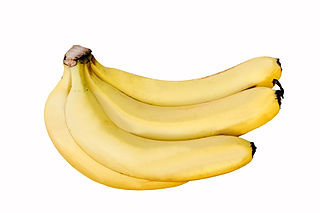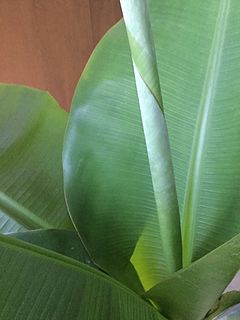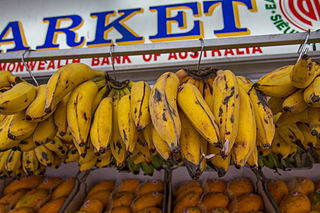Related Research Articles

A banana is an elongated, edible fruit – botanically a berry – produced by several kinds of large herbaceous flowering plants in the genus Musa. In some countries, bananas used for cooking may be called "plantains", distinguishing them from dessert bananas. The fruit is variable in size, color, and firmness, but is usually elongated and curved, with soft flesh rich in starch covered with a rind, which may be green, yellow, red, purple, or brown when ripe. The fruits grow upward in clusters near the top of the plant. Almost all modern edible seedless (parthenocarp) bananas come from two wild species – Musa acuminata and Musa balbisiana. The scientific names of most cultivated bananas are Musa acuminata, Musa balbisiana, and Musa × paradisiaca for the hybrid Musa acuminata × M. balbisiana, depending on their genomic constitution. The old scientific name for this hybrid, Musa sapientum, is no longer used.

Musa is one of two or three genera in the family Musaceae. The genus includes flowering plants producing edible bananas and plantains. Around 70 species of Musa are known, with a broad variety of uses.

Cavendish bananas are the fruits of one of a number of banana cultivars belonging to the Cavendish subgroup of the AAA banana cultivar group. The same term is also used to describe the plants on which the bananas grow.

Gros Michel, often translated and known as "Big Mike", is an export cultivar of banana and was, until the 1950s, the main variety grown. The physical properties of the Gros Michel make it an excellent export produce; its thick peel makes it resilient to bruising during transport and the dense bunches that it grows in make it easy to ship.

The Dwarf Cavendish banana is a widely grown and commercially important Cavendish cultivar. The name "Dwarf Cavendish" is in reference to the height of the pseudostem, not the fruit. Young plants have maroon or purple blotches on their leaves but quickly lose them as they mature. It is one of the most commonly planted banana varieties from the Cavendish group, and the main source of commercial Cavendish bananas along with Grand Nain.

The Goldfinger banana (FHIA-01) is a banana cultivar developed in Honduras. The cultivar, developed at the Honduran Foundation for Agricultural Research (FHIA) by a team of scientists led by Phillip Rowe and Franklin Rosales, has been bred to be pest-resistant and crop-yielding.

Red bananas are a group of varieties of banana with reddish-purple skin. Some are smaller and plumper than the common Cavendish banana, others much larger. When ripe, raw red bananas have a flesh that is cream to light pink in color. They are also softer and sweeter than the yellow Cavendish varieties, some with a slight raspberry flavor and others with an earthy one. Many red bananas are exported by producers in East Africa, Asia, South America and the United Arab Emirates. They are a favorite in Central America as a form of aphrodisiac juice, along with being a favourite in India in order to promote fertility but are sold throughout the world.

Grand Nain bananas are banana cultivars of Musa acuminata. It is one of the most commonly cultivated bananas and a member of the commercial Cavendish banana cultivar group. It is also known as the Chiquita banana because it is the main product of Chiquita Brands International.

Rhino Horn bananas, also called Rhino Horn plantains or African Rhino Horn, are hybrid banana cultivars from Africa. It produces strongly curved and elongated edible bananas which can grow to a length of two feet, the longest fruits among banana cultivars.

Musa acuminata is a species of banana native to Southern Asia, its range comprising the Indian Subcontinent and Southeast Asia. Many of the modern edible dessert bananas are from this species, although some are hybrids with Musa balbisiana. First cultivated by humans around 10 kya, it is one of the early examples of domesticated plants.

Saba banana, is a triploid hybrid (ABB) banana cultivar originating from the Philippines. It is primarily a cooking banana, though it can also be eaten raw. It is one of the most important banana varieties in Philippine cuisine. It is also sometimes known as the "cardaba banana", though the latter name is more correctly applied to the cardava, a very similar cultivar also classified within the saba subgroup.

Lady Finger bananas are diploid cultivars of Musa acuminata. They are small, thin skinned, and sweet.

The Latundan banana is a triploid hybrid banana cultivar of the AAB "Pome" group from the Philippines. It is one of the most common banana cultivars in Southeast Asia and the Philippines, along with Lacatan and Saba bananas.

Lakatan bananas, also spelled Lacatan, are diploid banana cultivars from the Philippines. It is one of the most common banana cultivars in the Philippines, along with the Latundan and Saba bananas.

Señorita bananas are diploid cultivars of the banana Musa acuminata originating from the Philippines. They are very small stout bananas which, like all bananas belonging to the AA cultivar group, are known for being extraordinarily sweet.

Musa 'Pisang Awak' is an edible banana cultivar belonging to the AABB banana cultivar group. This cultivar is grown worldwide.

Matoke, locally also known as matooke, amatooke in Buganda, ekitookye in southwestern Uganda, ekitooke in western Uganda, kamatore in Lugisu, ebitooke in northwestern Tanzania, igitoki in Rwanda, Burundi and by the cultivar name East African Highland banana, is a starchy triploid banana cultivar originating from the African Great Lakes. The fruit is harvested green, carefully peeled, and then cooked and often mashed or pounded into a meal. In Uganda and Rwanda, the fruit is steam-cooked, and the mashed meal is considered a national dish in both countries.

Musa × paradisiaca is the accepted name for the hybrid between Musa acuminata and Musa balbisiana. Most cultivated bananas and plantains are triploid cultivars either of this hybrid or of M. acuminata alone. Linnaeus originally used the name M. paradisiaca only for plantains or cooking bananas, but the modern usage includes hybrid cultivars used both for cooking and as dessert bananas. Linnaeus's name for dessert bananas, Musa sapientum, is thus a synonym of Musa × paradisiaca.

Cardava bananas, also spelled cardaba or kardaba, is a triploid hybrid (ABB) banana cultivar originating from the Philippines. It is primarily a cooking banana, though it can also be eaten raw. It is commonly confused with the more ubiquitous and closely related saba banana because they are used identically in traditional Filipino cuisine. Their common names can be interchanged in everyday usage though they are different cultivars.
References
- 1 2 Rema Menon (2016). "Banana Breeding". In Sukhada Mohandas & Kundapura V. Ravishankar (ed.). Banana: Genomics and Transgenic Approaches for Genetic Improvement. Springer. p. 16. ISBN 9789811015854.
- 1 2 3 John Charles Robinson (2010). Jeff Atherton (ed.). Bananas and Plantains. Crop Production Science in Horticulture. CABI. ISBN 9781845936587.
- 1 2 Jose D. Dagoon (2005). Agriculture & Fishery Technology IV. Technology, Livelihood Education, and Life Skills. Rex Bookstore, Inc. p. 34. ISBN 9789712342233.
- 1 2 T.K. Lim (2012). Edible Medicinal And Non Medicinal Plants: Volume 3, Fruits. Edible Medicinal And Non Medicinal Plants. Springer Science & Business Media. p. 503. ISBN 9789400725331.
- ↑ Richard Allsopp, ed. (2003). Dictionary of Caribbean English Usage. University of the West Indies Press. p. 336. ISBN 9789766401450.
- 1 2 3 4 Michel H. Porcher; Prof. Snow Barlow (2002-07-19). "Sorting Musa names". The University of Melbourne. Retrieved 11 January 2011.
- ↑ Valmayor, R.V., Espino, R.R.C. and Pascua, O.C. (2002). The Wild and Cultivated Bananas of the Philippines. Los Banos, Laguna, Philippines: PARRFI. p. 242.
{{cite book}}: CS1 maint: multiple names: authors list (link) - ↑ "ENCANTO FARMS "we be bananas" in San Diego" . Retrieved 13 January 2011.
